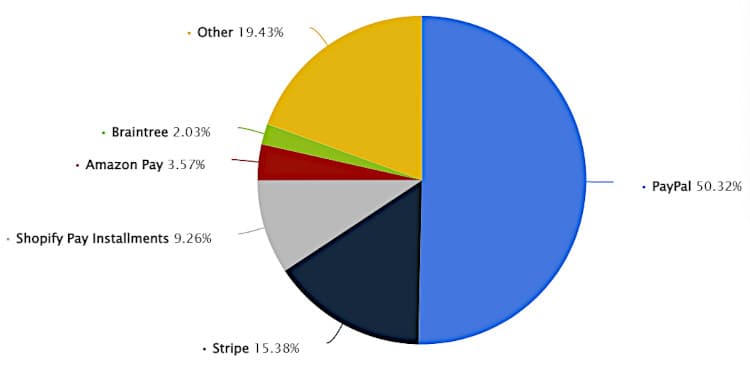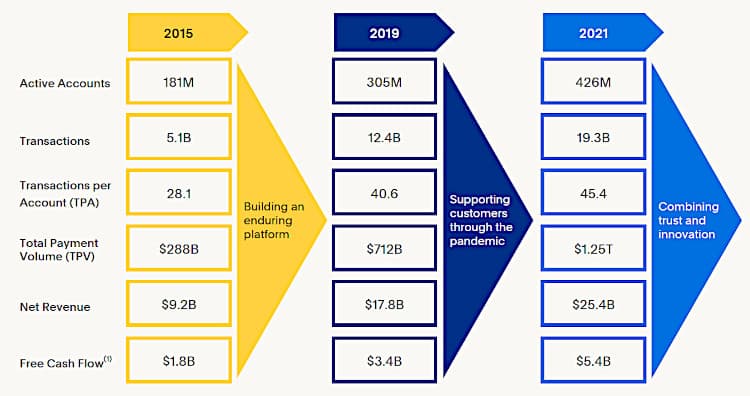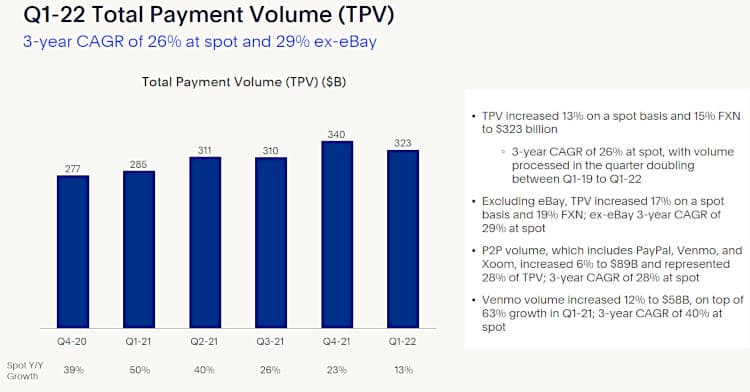PayPal Stock Plummets: Is it a Good Buy?
Table of contents

We’ve spent the last couple of years developing various rules, metrics, and guidelines to remove as much subjectivity and emotion out of our tech investing methodology. We’ve introduced a simple valuation ratio to determine if a tech stock is overvalued, though that’s less of an issue based on plunging market caps in today’s bear market. We’ve also preached about why tech stock size matters more, and not just on Reddit Tinder forums. Still, there are companies on paper that look good but we don’t buy because there’s only so much room in our tech stock portfolio. Then there’s PayPal stock (PYPL), the leader in digital payments processing, which is usually one of our go-to criteria for choosing a portfolio company.
We’ve always found enough reasons to avoid PayPal stock in the past when comparing it against other digital payments stocks, but we’ve never taken a super deep dive into the nearly 24-year-old company. That changes today, especially following our recent analysis into the one digital payments company that we do currently own. What, if anything, are missing about the potential in PayPal stock, which by many metrics is a good buy at today’s depressed prices. (PayPal is hitting new 52-week lows as we type this, and now trades less than it did during the short-lived pandemic rout of March 2020.)
A Very Brief History of PayPal

While PalPal hasn’t been around quite as long as the Simpsons (33 seasons and counting), it has some longevity for a tech company, in spite of reportedly being named one of the worst business ideas of the year after it was founded in 1998. It survived the Dot-Com Boom and Bust, and names like Peter Thiel and Elon Musk are long gone (though the hair grew back). In those early internet days, it actually paid people to sign up for its pay-via-email service because it needed at least one million customers to make the business model work. Below you can see the market share of payment processing software technologies worldwide as of 2021.

Fast forward 20 years or so and PayPal now has 426 million active accounts, including 34 million merchants. Consumers pay fees on everything from converting foreign currency to making instant transfers from their PayPal or Venmo to a bank account, and even buying cryptocurrency. Merchants using PayPal as their digital payments processor pay fees on transactions and other payment-related services. Revenues also include interest and fees earned on business loans, as well as so-called “buy now, pay later” services to consumers (more on that below).
Just over 92% of PayPal’s revenues fall into the rather opaque revenue segment “Transaction revenues” with no breakdown provided as to the mix of merchant fees vs customer fees.

As a merchant ourselves, we moved away from PayPal because their fee structure was too high. Knowing how merchant revenues are growing relative to consumer transaction revenues would be particularly useful. So would further granularity of any kind. For example, we’d be very interested in knowing how much revenue is being generated from cryptocurrency transactions, or what industry segments dominate merchant revenues.
How Losing eBay Hurts PayPal
We can’t talk about PayPal history without mentioning eBay. The former spent about a dozen years as a subsidiary to the latter before it returned to being an independent public company in July 2015. And there’s been plenty of drama before and since the split. The breakup has hit PayPal’s top line a couple of times in recent years. In 2018, eBay opted to go with Amsterdam-based Adyen (ADYN.AS) as its back-end digital payments processor. Last year, the e-commerce company made the new payments platform mandatory for all sellers.
That brings us to PayPal’s 2021 revenue of $25.4 billion, which represents 18% growth compared to the previous year. Not bad, but PayPal CEO and president Dan Schulman is quick to note that it would have been closer to 29% excluding eBay. The shift to Adyen cost PayPal about $1.4 billion in revenue last year and is expected to put a damper on revenues this year. To put it another way: In 2020, eBay accounted for 13% of total revenue, while last year that dropped to just 6%. We talk all the time about customer concentration risks, and here we see the consequences in action. Nonetheless, key metrics for PayPal are still moving in the right direction.

PayPal is still an $85 billion company, more than three times as big as eBay by market cap with nearly 2.5 times the revenue. Neither company has outperformed the +145% return by the Nasdaq since PayPal went public in July 2015. If we had written this article a year ago, it would be a very different story. In June 2021, PayPal was up more than +600% versus +225% for eBay, and +150% for the Nasdaq. It just goes to show you that you can’t time the market, as well as underscores that age-old concept that past performance does not guarantee future results.
Pumped Up by the Pandemic
But the overall trend is ever upward: PayPal processed $1.25 trillion in total payment volume and had a record 5.3 billion transactions in Q4-2021 alone. In the last two years, it has added 122 million net new active accounts (NNAs) – nearly 30% of total active accounts. But best not to read too much into those last numbers, which were definitely pumped up by the pandemic. Schulman said as much during the Q4-2021 earnings call earlier this year, noting that a number of those new accounts were one-and-done transactions, and it’s probably not worth the company’s marketing dollars to pursue them.
“Our view is that spending money on lower-value NNAs that are not engaged in the base becomes an increasingly expensive proposition over time and does nothing for our revenue growth. In fact, this year, when we’re saying that we’re going to do 15 million to 20 million, it’s probably going to be about 20 million incremental one-and-done customers that roll off that does nothing to our revenue.”
Dan Schulman, PayPal CEO and president
Indeed, about a third of PayPal’s customers make up “the vast majority” of its total payment volume. Management has decided that chasing a total of 750 million NNAs in the mid-term was just a feverish COVID dream and is instead focused on increasing spend by its customer base through its app and digital wallet. That’s because it’s no longer about what card you have in your wallet but who manages your wallet when it comes to digital payments. The management team is pretty keen on the traction so far, with transactions per active account up 11%, despite tens of millions of accounts that see relatively little activity. In addition, average revenue per active account doubles when somebody uses the PayPal app versus just checking out through a third-party website.
How PayPal Makes Money Beyond Transaction Fees
More than 90% of PayPal revenues come from various transaction fees to both businesses and consumers, mostly fueled by merchant payment processing and currency conversions (so sayeth the word on the street). But it’s worth talking briefly about some of the other ways that PayPal makes money beyond transaction fees. This revenue, which mostly revolves around loans, increased by $433 million to nearly $2 billion. The jump of 28% isn’t quite that impressive considering most of the increase came from servicing pandemic loans through the U.S government’s Paycheck Protection Program and its existing credit card business.
One intriguing stat: The amount of money that consumers and merchants owe PayPal increased 48%, from $3.6 billion to $5.3 billion. That could keep growing at a pretty good clip, as PayPal recently expanded its so-called “buy now, pay later” service to match similar moves to Apple Pay and others. PayPal now allows consumers to break down costs of up to $10,000 into monthly payments across a six- to 24-month period (up from the previous $600 limit), with a risk-based annual percentage rate (presumably using algorithms for a real-time turnaround) ranging from 0% to 29.99%.
In the old days, we had layaways, which allowed customers to get their stuff made in China only after they’ve finished their monthly payment plan. The model in today’s instant gratification economy is to get your stuff now and hope that you have enough COVID-19 antibodies in your blood to qualify for the higher price point for selling your plasma. Unsecured personal loans are no business we want a part of given the current economic climate, at least on the consumer side. There’s a big difference between loaning money to a business with a decade-long track record of revenues via PayPal vs. lending Gwenyth in HR $10,000 so she can buy that new Coach bag before layoffs begin.
PayPal Acquisitions and Investments
Some recent acquisitions are definitely driving some of the company’s latest strategies post-eBay, starting with the “buy now, pay later” services. For example, it paid $2.7 billion last year to acquire Paidy, a Japanese version of PayPal that primarily provides installment credit offerings to the locals. It also gobbled up four other companies in 2021 for a total of $542 million, including a firm called Happy Returns that focuses on reverse logistics. And back in 2019, PayPal sweetened its portfolio with the $4 billion acquisition of Honey, which has developed a shopping app for tracking deals and finding coupons. Venmo, of course, has been part of PayPal since it acquired Braintree for $800 million back in 2013.

On the flip side, PayPal has invested in about two dozen companies over the years, including nine since 2020. The investments also reflect the company’s strategy to expand its reach beyond digital payments and into e-commerce, banking, and cryptocurrency. Many are also investments in non-U.S. companies, which are probably attempts to enlarge PayPal’s international revenue streams. Last year, nearly 55% of revenues came from the United States. For instance, a company called Home Lending Pal uses AI to automate the mortgage process, while a Colombian fintech offers micro-investments to small businesses. PayPal led a more high-profile $375 million Series F for Gojek, an Indonesia super app with about 20 services, doing everything from ride-hailing to digital payments. Globally, PayPal sees a $110 trillion opportunity with plans to hit $50 billion in revenues by 2025.
Should You Buy PayPal Stock?
At its core, PayPal remains a digital payments stock, but appears to be positioning itself across a number of fintech verticals, including e-commerce, banking, and crypto/blockchain. It also offers investors exposure to foreign currency and (very indirectly) an international portfolio of startups. There are a lot of moving parts and potential, but it doesn’t appear that anything will move the needle much in the near-term. PayPal expects to increase total revenue between 11% and 13%, which is relatively low for a growth tech stock, though somewhat understandable given its large size. On the other hand, PayPal does not entirely qualify as a value stock under the traditional definition, especially since it doesn’t offer a dividend. It seems to be stuck somewhere in the middle.

Globally, PayPal sees a $110 trillion opportunity with plans to hit $50 billion in revenues by 2025. If we had more color around that large catch-all reporting segment, we might be able to deduce how they plan to get there.
Conclusion
PayPal is growing into a powerful tech company, and an argument could be made that at its current price, PayPal stock is trading at a relative bargain. But the growth story is hard to read through the fog of the post-pandemic economy and opaque reporting structure. Everyone is fleeing crypto, so probably fewer transaction fees to collect. Consumers are likely to pull back on spending, so again fewer transaction and interest rate fees to collect. The war over digital wallets is just beginning, and it’s way too early to declare PayPal the winner.









Look at another payment processing company: StoneCo (STNE) from Brazil. It is much smaller (market cap: $2.5B), but possible upside is much larger ..
We’re happy to sacrifice a much larger upside in exchange for much less potential downside. We’ll take a look at StoneCo, thank you for the heads up.